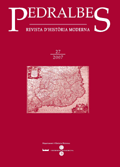Polémicas historiográficas y confrontación de identificaciones colectivas en el siglo XVII: Navarra, Aragón y Vasconia
Keywords:
Historiography, seventeenth century, Navarre, Juan de Sada, José de Moret.Abstract
The making of a new identity for Navarre, once it was incorporated into the Spanish Monarchy, drew much from confronting it with those of neighbouring territories. It both adapted and rejected several elements from them. Baroque historiographic polemics preferentially confronted among themselves close communities with a long, common history, rather than “national” chorographies with histories of the Monarchy. The Historia apologética y description del reyno de Navarra (1628) by Juan de Sada, and the Anales del reyno de Navarra (1628) by José Moret synthesized the main characteristics with which the Navarrese sought to identify themselves. They slowly abandoned the myth of Sobrarbe on the origins of crown and kingdom, which they shared with the Aragonese until the mid-sixteenth century and accepted the novel assumption of a primary, uncontaminated “Vascony”, adapting the old myth of Cantabria to a new context.Downloads
Published
How to Cite
Issue
Section
License
Copyright (c) 2007 Alfredo Floristán

This work is licensed under a Creative Commons Attribution-ShareAlike 4.0 International License.
Authors must agree with the following terms:
1. The author keeps authorship rights, ceding the journal the right to first publication.
2. Texts will be disseminated with a Creative Commons Attribution 4.0 International License. Which allows for the work to be shared with third parties, as long as they recognise the work’s authorship, the original publication in the journal and licensing conditions.
This requires acknowledging authorship appropriately, providing a link to the license, and indicating if any changes have been made. It can be indicated in any reasonable way, but not in a manner that suggests the licensor endorses or sponsors the use of the text.
If content is remixed, transformed, or new content is created from the journal's texts, it must be distributed under the same license as the original text



